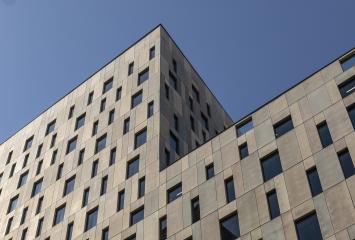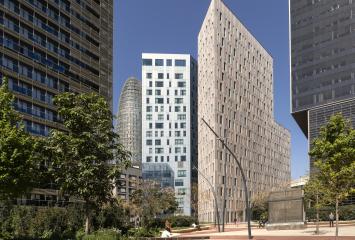Building a Corporate Culture through Office Design
All organizations develop a personality based on principles, values, norms, practices, and aspirations, collectively known as corporate culture. Its construction takes place across multiple dimensions: company policies, management behavior, employee conduct, public communications, and, often overlooked by some companies, office space design. After all, the environment in which companies operate is crucial in conveying values, executing practices, and achieving aspirations.
Putting Company Values into Practice
Prosocial values may look good on paper, but corporate culture is not built on words alone; it's built on the application of those words in real life. The design of an office plays a significant role in this. At Colonial, for example, we uniquely prioritize sustainability in all phases of building: construction, rehabilitation, and operation. Companies occupying our assets and operating from them convey a strong and unequivocal commitment to environmental protection to both their employees and clients. Sustainability becomes a practical part of their corporate culture.
However, sustainability is not the only value that Colonial's office design solidifies in the culture of companies; there is also transparency and open communication. Our buildings prioritize flexible spaces, allowing workers to connect freely and participate in daily activities. Manifesting a commitment to transparency in a statement is legitimate, but making it a daily reality for employees is much more important. This is how corporate culture permeates individuals, making them embrace it and become advocates for it.
On another note, of all the values of a modern organization, perhaps the most important for its members is the human-centric approach, where business policies largely focus on the well-being of workers and clients. Office design plays a fundamental role in this: thermal insulation for comfort, measures to promote exposure to natural light, the presence of vegetation connecting people with nature, and window orientation for pleasant views are just some ways the design communicates this value.
Bringing the Company Closer to its Aspirations
The relationship is clear: office design defines what happens within it, which, in turn, entails values that gradually build a unique corporate culture. However, as mentioned at the beginning of this article, corporate culture is not only composed of moral aspirations but also business aspirations. Organizations have goals, shaping who they are, much like an individual's personal goals define them. In this regard, once again, office design either brings a company closer to or further from those collectively established goals, and in multiple different ways.
For instance, an office design that favors technological integration will promote productivity and support a culture that strongly values both efficiency and innovation. The presence of flex spaces enhances interconnection between departments and workers, fostering synergy that inevitably leads to greater overall creativity. Additionally, having relaxation and socialization spaces in the office promotes individual happiness, as demonstrated by a study from the consulting firm Sustainable Growth, increasing productivity by 80%. A figure that can make a difference in achieving aspirations.
In conclusion, it is crucial to move from a simplistic view of office design as merely an aesthetic and sensory matter to a deeper understanding of its influence on the values, practices, and aspirations of companies. Not only because the former leads to a missed opportunity in building a healthy corporate culture but also because leaving office design at a purely aesthetic level can project values and encourage undesirable practices that shape a corporate culture contrary to what is desired. Office design should be thoughtful and entrusted to the best hands.

